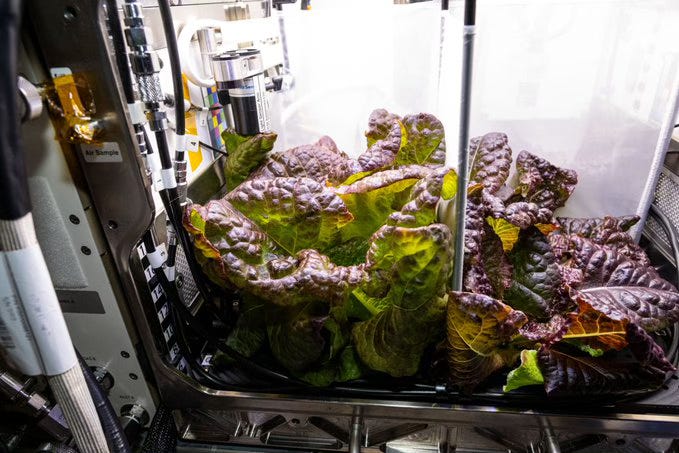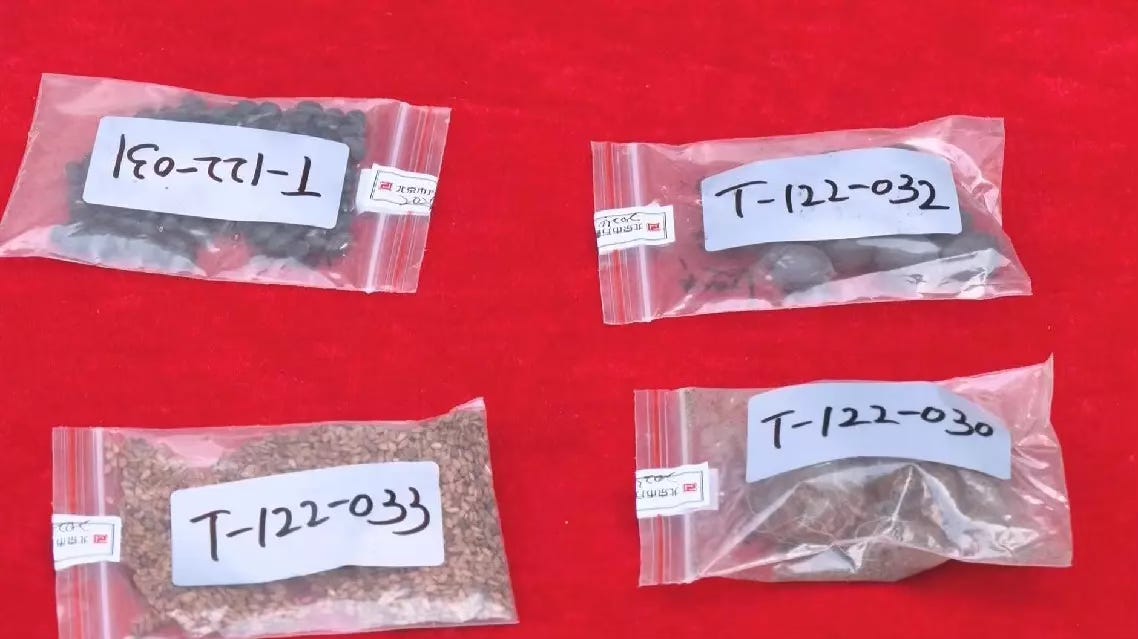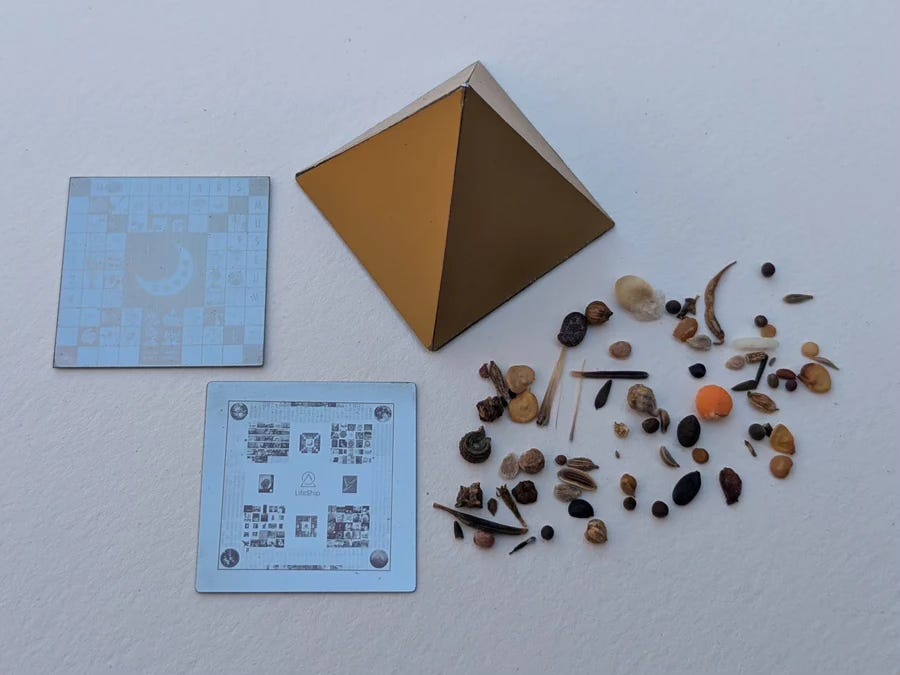Gardeners of the Galaxy Mission Report: 14 January 2025
Your weekly round-up of astrobotany news and adventure. This week we've got a seed bank heading for the Moon, a wooden satellite deployed, and an update on India’s POEM-4 experiments.
Hello, Gardeners of the Galaxy! Welcome to this week's Mission Report.
Blue Origin’s attempt to launch its New Glenn spacecraft ended in a scrub yesterday, but Firefly Aerospace is currently targeting tomorrow (15 January) for the launch of its Blue Ghost Mission 1 to the Moon. With a transit time of around 45 days, the Blue Ghost lander is expected to touch down on the lunar surface in early March. It’s carrying 10 NASA science investigations to investigate the Moon’s environment and help prepare for future human missions there.
Also along for the ride is LifeShip’s Pyramid, a monument, cultural archive, time capsule, and messenger probe – and the first seed bank on the Moon.
The Pyramid includes:
Plant Seeds from 100 species. A global seed bank of our most common plants that humans have relied upon for thousands of years.
The complete human genome, digitized into Cerabyte ceramic storage designed to last a billion years. We've eternalized the human blueprint.
The code for an AI Large Language Model (LLM) trained as humanity’s messenger probe.
Sacred waters and crystals from 33 sites worldwide.
Stories, wishes, and prayers from 25,000 people.
All of Wikipedia, encoded in DNA, in partnership with Arch Mission Foundation and printed in DNA by Catalog.
A message to future civilizations by the Interstellar Foundation.
Collections from MoonDAO, Copernic Space, United Planet, The Museum of Ideas, and more.
Blockchain wallets stored in molecular DNA with Iridia and Ocean Protocol.
Featured art collections stored on NanoFiche from artists Amy Karle, Richelle Ellis, Ed Kac, and gallery collections by MoonMars, LunARC, and Lunar Codex.
Assuming that everything goes OK with the launch and the landing, Blue Ghost and the Pyramid will remain on the Moon forever.
References
Abbey A. Donaldson, NASA Sets Coverage for Firefly First Commercial Robotic Moon Launch, NASA.gov, 10 Jan 2025. https://www.nasa.gov/news-release/nasa-sets-coverage-for-firefly-first-commercial-robotic-moon-launch/
Ben Haldeman, A Pyramid on the Moon!, LifeShip, 1 Aug 2024. https://lifeship.com/blogs/lifeship-mission-control/were-putting-a-pyramid-on-the-moon
In other news...

ispace Mission 2 will launch on the same SpaceX rocket as Blue Ghost Mission 1. It includes the RESILIENCE lunar lander and TENACIOUS micro rover, a model of an iconic Swedish red house with white corners, and and a module designed to conduct the first food-production experiment on the Moon, using the micro-algae Euglena, developed by Japanese company Euglena.
LignoSat, JAXA’s wooden satellite, was one of five deployed into Earth's orbit from the International Space Station in December.
Read more: JAXA's first wooden satellite deploys from space station
India’s POEM-4 mission is ongoing, but the CROPS experiment has completed its objectives by germinating cowpeas in space. A second astrobotany experiment, growing spinach callus tissue is doing well.
Read more: CROPS in Space

Seeds flown on China’s Shijian-19 satellite were recently returned to Hainan Province in south China. The seeds, weighing 102 grams, included taro, black beans, sesame, and lotus. Researchers at the Tropical Agricultural and Forestry College at Hainan University will be selecting and cultivating the seeds before a trial planting.
Read more: Space seeds handed over in China's Hainan Province for selection, cultivation before planting
Laura Lee, a graduate research assistant at Northern Arizona University presented a research poster at the 2024 American Geophysical Union, with results showing that crops grew better on lunar regolith than Martian regolith. The team tried growing the crops with Milorganite, a brand of fertilizer made of heat-treated microbes that digest wastewater, but found that pure nitrogen fertilizer offered better results.
Read more: Food grows better on the moon than on Mars, scientists find
“Nematodes to the Rescue” is one of the student (SSEP) experiments currently onboard the International Space Station. It is investigating the effects of microgravity on nematodes, which could become a practical solution for controlling pests when growing crops in space and on Mars.
Read more: Out of this world: Hillcrest High’s eco-friendly pesticide experiment reaches ISS
The zebrafish that accompanied the Chinese astronauts on last year's Shenzhou 18 mission set a record for being the longest surviving fish in space, according to the professor researching them.
Read more: Zebrafish spend record time alive aboard China's space station
José Andrés Group (JAG) is working with engineer Jim Sears of Ascent Technology to research and develop recipes for SATED Space, a cooking device designed to prepare food in zero gravity. SATED, which stands for "Safe Appliance, Tidy, Efficient and Delicious," won honours and funding in last year's NASA Deep Space Food Challenge. It uses a cylindrical cooking chamber spinning at variable speeds to push food against the heating elements, allows for cooking via conduction. From dry mixes, SATED can turn out cornbread with a cheesy, caramelized crust, pizza, or warm brownies.
Read more: Cosmic chili: José Andrés Group is helping pioneer cooking in space
Robotic spacecraft have visited every planet in the solar system, as well as many asteroids and comets, but humans have only gone to two destinations: Earth's orbit and the Moon. Will we still need astronauts in the future?
Read more: Future of space travel: Could robots really replace human astronauts?
In active galaxies, carbon and other star-formed atoms take a circuitous journey on giant currents that extend into intergalactic space. These currents resemble giant conveyer belts that push material out and draw it back into the galactic interior, where gravity and other forces can assemble these raw materials into planets, moons, asteroids, comets and even new stars.
Read more: Carbon in our bodies likely left galaxy and came back on cosmic 'conveyer belt'
Canadian company Plantaform introduced its eponymous smart indoor garden powered by "fogponics" at CES 2025 in Las Vegas. Marketed as a "Nespresso for your vegetables", it uses an ultra-fine vapor to hydrate plants, resulting in faster growth and 30 to 50 percent less water usage compared to standard hydroponic systems.
Read more: The Plantaform smart indoor garden uses NASA tech to grow plants with fog

Recent research suggests that hornworts may hold the key to allowing plants to turn more carbon dioxide into biomass, which could boost crop yields and even combat climate change.
Read more: Tiny plants reveal big potential for boosting crop efficiency
In Lithuania’s Dzūkija National Park, losing yourself amongst the pine trees while hunting for mushrooms is an occurrence so common it has its own word: "nugrybauti".
Read more: The national park that draws mushroom hunters from around the world
A fourth-generation Japanese-American farm in California focuses on growing heirloom stone fruits and grapes, including the Elberta peach - an almost-extinct heirloom stone fruit.
Read more: Inside the Japanese-American Farm Preserving Endangered Fruit
The RHS Chelsea Flower Show 2025 will feature an underwater flowering plant for the first time. The Seawilding Garden will feature seagrass, the ocean's only flowering plant. Inspired by the shores of Loch Craignish in Argyll and the restoration efforts of Scottish charity Seawilding, the garden will highlight the actions taken by a remote rural community to reverse biodiversity loss by restoring keystone species seagrass (Zostera Marina) and native oysters (Ostrea edulis) to their waters.
Read more: Chelsea Flower Show 2025 to feature underwater garden for the first time
I'll be back in your inboxes next week. Thanks for reading and being part of the Gardeners of the Galaxy community.
Ex solo ad astra,
Emma (Space Gardener)




